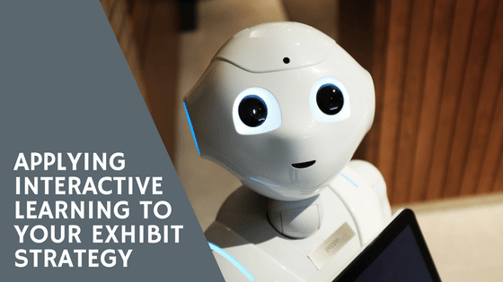
Do you remember sitting in class as a student and fighting the urge to close your eyes as your teacher or professor droned on through his or her lecture for the day? A similar feeling may wash over your exhibit attendees if you’re not careful. Between countless one-sided product demonstrations and sales-tinged conversations with booth staff, attendees often leave the show floor without absorbing your key message or worse, they leave not wanting to engage further with your company.
But, how can you avoid this humdrummery? Consider ways to transform your brand’s messages into something even the ghosts of students' past would sit up for and pay attention to. Here are some ways to apply interactive learning techniques to your overall exhibit strategy:
Let attendees warm-up their learning muscles: If your attendees are anything like me, having a long conversation with a sales person is not what I would call inspiring. If I see a booth staffer standing alone ready to attack, I’m more likely to walk right past your exhibit and research the company on my own or not at all.
Instead, consider re-working the flow of your trade show display with your exhibit designer or agency so that attendees are drawn to interactive displays or an automated product display first with a booth staffer nearby to answer questions or engage when the attendee is ready and their engagement muscles are limber.
Don’t Google “cost to rent an AI robot” just yet: Sure, an AI with a friendly demeanor and stores of knowledge to engage attendees is a really exciting and cool concept, but it’s not yet what we would call accessible for all marketing budgets and it doesn’t work for every brand.
Something as simple as an iPad can act as a great tool to engage your attendees provided the right content is loaded and easy to use. Scrolling through long articles or heavy content is probably not the best use of an attendee’s time, but maybe a fun and interactive quiz that illustrates key messages might grab their attention. Or perhaps it ties to a giveaway or social promotion to keep them engaged long after the trade show ends and to foster data collection.
The key is to think creatively and help attendees solve their problem with your solution through interaction with your brand, your message, your product and your on-site experts. And if you need a little help and have the budget for it, multimedia agencies can help with everything from branded games to virtual reality experiences.
Who is Alex Trebek?: Game night is a staple in my social circle and it is one of those activities that seems to bridge the gap among all generations and personality types. This commonality has led businesses to incorporate elements of games into their daily processes and programs as well as their business strategy through what has been coined gamification. Take corporate wellness programs for example that offer rewards based on an employee’s participation and completion of challenges designed around the brand and a carefully defined outcome. Over the years, exhibitors in trade shows and events have adopted this concept seeing the value and increased levels of engagement.
The idea here is to entertain your attendees, create a little buzz around your exhibit, but to also subtly educate and inform your audience about your brand. The goal is to keep them in your space, let them have some fun and give you an opportunity to make a meaningful connection.
Technology in the form of apps and interactive displays will be a big help if this is something that you think works for your brand and your message.
Avoid demo downfalls: A product demo seems like a no-brainer – show your audience what your tool, service or product can do, right? Wrong. You have to show them what it can do for them and to solve their individual problem or to fulfill their individual need. This is where knowing your audience extremely well and designing a personalized demo comes into play.
Perhaps explore a demo where at the very least, your attendees can get hands on with it and truly experience it themselves through technology-based tactics. The powerful combination of a physical and mental engagement with your product or idea is a great way to leave a lasting impression.
If you are planning a live demo, make sure your presentation invites the audience to actively participate. The worst thing that can happen is that your attendees politely listen to your demo and watch from a distance, while not entirely absorbed in what you are saying or what the key takeaway is (and by not entirely absorbed, I mean that they are actively distracted thinking about what to eat for lunch and if their kid at home got that project done or why they didn’t break-in these shoes prior to the conference). They will likely walk away not fully understanding your product or service, or what you can do for them, and you will have missed an opportunity.
Research and preparation is your bestie for this one. Create a logical flow of information for the attendee, refer to questions your customers asked you during on-boarding and what your prospects often stumble on, and design your demo around this. And if the demo is not engaging and interactive, scratch it and focus your efforts on something else.
CONCLUSION:
Simple changes to how you tell your brand’s story on show site can mean the difference between a yawning and uninterested audience and one that fully understands what your brand can do for them. Whatever tactic you choose, the goal is for your trade show display to offer a level of interactivity that leaves an imprint, hopefully getting you one step closer to converting each person from lead status to a customer.

 404-296-5282
404-296-5282 3237 Satellite Blvd
3237 Satellite Blvd